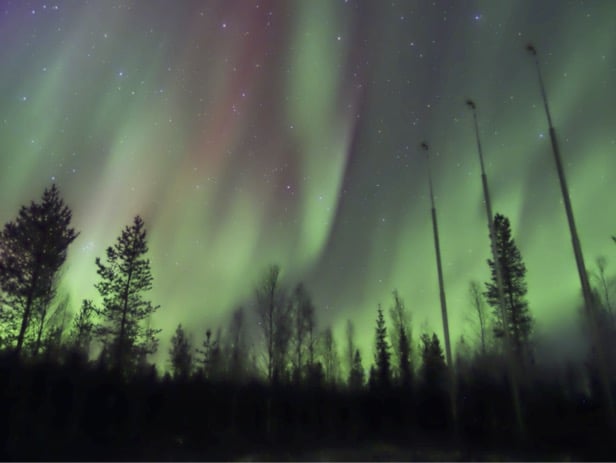Extreme solar storms provide unique fingerprints for exact radiocarbon dating
On 1-2 September 1859, telegraph systems across Europe and North America failed to function and started sparking, in some instances causing fires. Hours before that, researchers had observed the first ever confirmed solar flare, warning something big was about to hit the planet. Most of the northern and southern skies lit up in a brilliant light display, signalling a massive geomagnetic storm had hit the plant – now known as the “Carrington Event” – one of the strongest in documented history. However, this Carrington Event provides only a small indication of the Sun’s ultimate power. Looking further into the past we see evidence for solar storms that are even more extreme than the Carrington Event.
If such an extreme solar storm was to occur today, it could well have disastrous impacts on our highly technological society damaging our satellites, communications networks and global electricity grids. Today’s review article in Nature looks at how to detect these extreme solar storms further back in the past. Not only do these new insights help us better understand how often they occur – helping society to better prepare – but these extreme solar storms can also be used to better understand solar physics, how our planet works, and how we can date the archaeological record with far greater accuracy than has been possible before.
Detecting extreme solar storms is made possible by radiocarbon, a naturally occurring radioactive isotope that is produced in the atmosphere. When these solar storms take place, we see radiocarbon production levels spike far above natural levels. The first discovery of such an extreme solar storm was made by Fusa Miyake by measuring radiocarbon levels in individual Japanese tree rings. This storm occurred in AD774.
Over the past decade, efforts to measure yearly radiocarbon concentrations within the annual growth rings in ancient trees have confirmed four more extreme solar storms in our past, occurring in AD 993, AD 774, 660 BC, 5259 BC and even 7176 BC – while several other possible events are still being investigated. Many of these storms were orders of magnitude larger than all solar particle storms directly recorded during the past decades.
Prof. Tim Heaton, Professor of Applied Statistics at the University of Leeds said, “Radiocarbon is a phenomenal tool to understand the past – not just to date archaeological objects but also to understand how the Earth actually works, from the critical processes within our Sun to those hidden deep in our oceans.”
Solar storms are not all bad however. The peak in radiocarbon levels seen during storms also provide unique benefits to scientists. The large spikes in radiocarbon are extremely helpful to archaeologists and environmental scientists when radiocarbon dating, allowing highly precise dates for sites that were built around the time of the extreme solar storms. Sometimes, we can even identify the unique storm fingerprints in the radiocarbon levels and date historical sites and events down to the exact year. Examples include dating the Viking site in Canada known as L’Anse aux Meadows and the Latvian timber lake fortress at Lake Āraiši in Latvia.
Dr. Alex Bayliss (Head of Scientific Dating at Historic England) explains that, “the significance of the new annual calibration data goes far beyond exact dating to the year. For example, it means that even small timbers from historic buildings can be dated to within little more than a decade, which is a real practical advance in protecting our heritage.”
Importantly, radiocarbon changes during extreme solar storms also allow us to gain a better understanding of environmental processes on Earth, including the circulation of the atmosphere and ocean. Indeed, these extreme solar storms have such a large impact on the radiocarbon budget of the planet, they can provide new insights into how the global carbon cycle under past – and potentially future – climates.
These extreme solar storms take place against a background of longer-term fluctuations of the Sun. However, their exact cause and longer-term variations with the better-known sunspot cycles are still mysterious. Current models of physical processes in the Sun are still unable to reproduce these behaviours of our variable star. Understanding extreme solar storms and sunspot cycles may hold the key to better simulating and predicting the activity of the Sun and related space weather.
Prof. Ilya Usoskin (Head of Oulu Cosmic Ray Station, University of Oulu) says, “We expect that the annually-resolved radiocarbon measurements will lead to a breakthrough in understanding of the nature of extreme solar eruptive events, whether they belong to Dragon King or Black Swan families”.
Current comparisons between radiocarbon-identified extreme solar storms with historic observations are yet unable to distinguish between two competing solar physics scenarios. In the ‘Black Swan’ scenario, these events are simply larger-scale versions of regular solar storms. But in what’s known as the ‘Dragon King’ scenario, they are physical phenomena distinct from the historic observations. As more extreme solar storms are identified from the radiocarbon record, they will help enhance our understanding of solar physics, and plan for future events.
Prof. Edouard Bard (Professor of Climate and Ocean Evolution at the Collège de France) says, “The scientific community is racing to search and analyse new subfossil trees from different regions of the world, including the Southern French Alps. The goal is to strengthen the existing records and to discover new extreme solar storms of the past.”
Publication
Nature, 11 September 2024, Extreme Solar Storms and the Quest for Exact Dating with Radiocarbon. 10.1038/s41586-024-07679-4
DOI: 10.1038/s41586-024-07679-4
Contact details
T J Heaton
M Blaauw
Ilya Usoskin
Edouard Bard
University of Leeds press office
Further Information
Heaton TJ, Bard E, Bayliss A, Blaauw M, Bronk Ramsey C, Reimer PJ, Turney CSM, Usoskin I.


